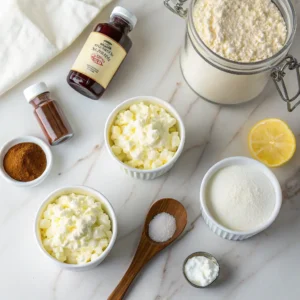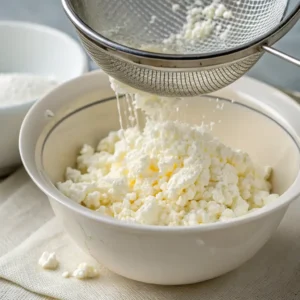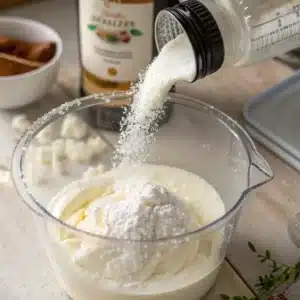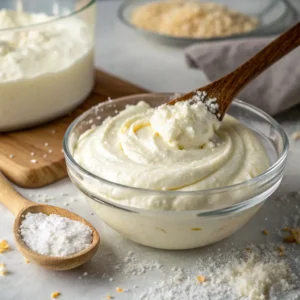If you have ever stood in the baking aisle debating whether to go all-in on decadent cream cheese frosting or stick with something lighter, you will appreciate today’s topic, cottage cheese frosting. It is smooth, creamy, and surprisingly versatile. In this article, you will learn why cottage cheese frosting deserves a permanent spot in your recipe box, how to make it step by step, ways to use it beyond cake, plus tips to troubleshoot common issues. Along the way, i will share a bit of my own journey with cottage cheese, because this humble dairy product has been at the center of so many transformations, mine included.
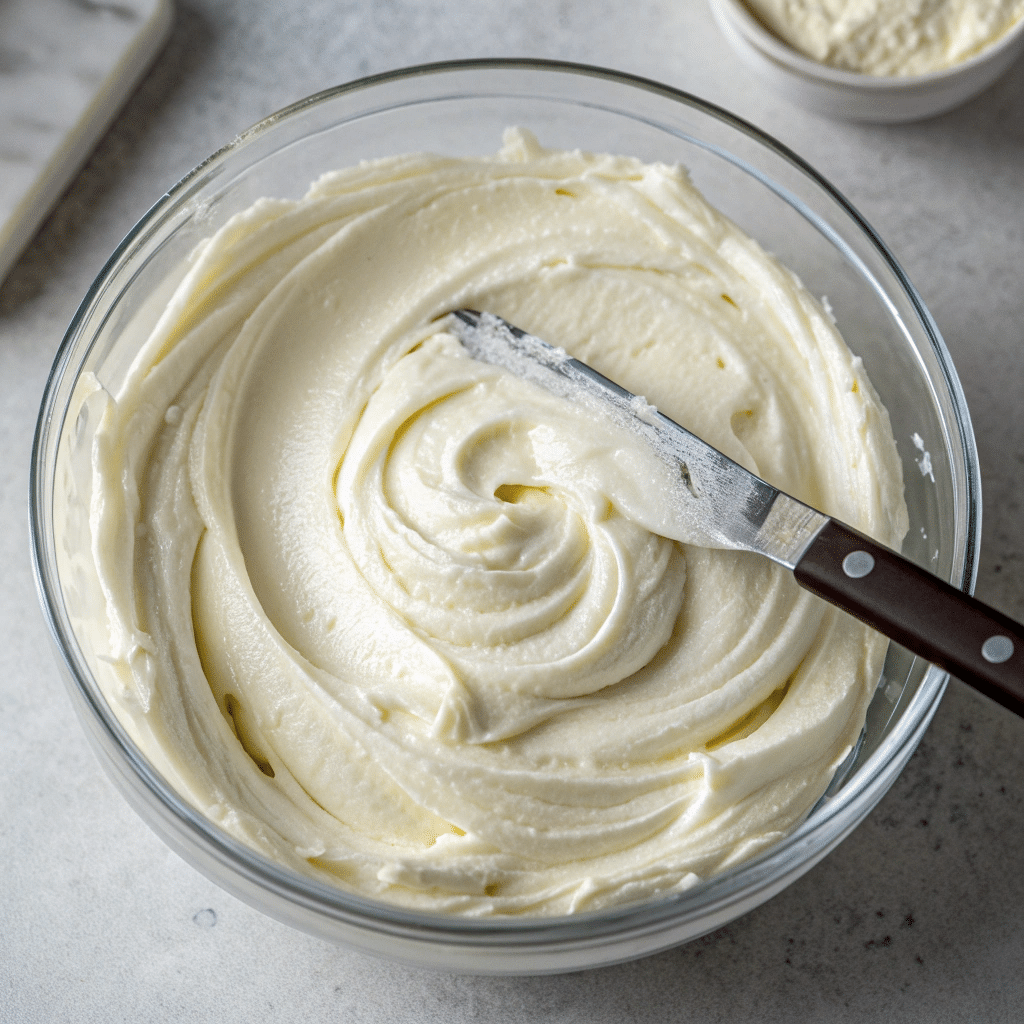
Table of Contents
Table of Contents
My Cottage Cheese Story and Why Frosting Matters
How I Discovered Cottage Cheese Frosting
I never imagined cottage cheese would end up in something as indulgent as frosting. Back in my college apartment, where my “kitchen” was basically a hot plate and a mini-fridge, I relied on cottage cheese because it was cheap and full of protein. I first tried blending it smooth to spread on toast, and honestly, the texture surprised me. It had this creamy, slightly tangy quality that felt a lot like cream cheese. That little experiment eventually turned into my obsession with making desserts healthier without tasting like cardboard.
Fast-forward a few years, when clients at my nutrition practice asked for lighter dessert swaps, the idea clicked: why not whip cottage cheese into frosting? I found it is not just lighter, it is also higher in protein and lower in fat than traditional cream cheese frosting. And the best part? It still tastes rich and satisfying.
My first full attempt was on a carrot cake I baked for a client’s birthday. To both of our shock, everyone finished their slices without realizing they were not eating cream cheese frosting. That moment sealed the deal; cottage cheese frosting went from accidental discovery to a staple in my kitchen.
Print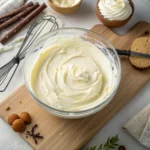
Cottage Cheese Frosting
- Total Time: 10 minutes
- Yield: 2 cups frosting
- Diet: Vegetarian
Description
A smooth, creamy, and protein-rich alternative to traditional frosting, cottage cheese frosting is versatile, light, and indulgent without being heavy.
Ingredients
- 2 cups small-curd cottage cheese, drained
- 1/3 cup powdered sugar or honey
- 1 teaspoon vanilla extract (or almond/lemon extract)
- Optional: 2 tablespoons cocoa powder, lemon zest, or spices for variations
- 1 tablespoon cornstarch or protein powder (if needed for thickening)

All ingredients needed for homemade cottage cheese frosting recipe
Instructions
- Drain excess liquid from the cottage cheese.

Drain excess liquid from small-curd cottage cheese using fine-mesh strainer - Blend cottage cheese in a high-speed blender or food processor until completely smooth (2–4 minutes).
- Add powdered sugar or honey and blend again until creamy.

Add powdered sugar and vanilla extract to blended cottage cheese - Mix in vanilla extract (or flavor variations such as almond, lemon, or cocoa).

Mix in vanilla extract for flavor in cottage cheese frosting - If too thin, add cornstarch/protein powder or chill for 20 minutes.

Add cornstarch if frosting is too thin for proper consistency - Use to frost cakes, muffins, cupcakes, or brownies.
Notes
Chill before using for best texture. Easily customizable with chocolate, lemon, or spices.
- Prep Time: 10 minutes
- Cook Time: 0 minutes
- Category: Dessert
- Method: Blended
- Cuisine: American
Why Cottage Cheese Frosting Works So Well?
The beauty of cottage cheese frosting is its versatility. By blending cottage cheese until velvety smooth, you create a neutral base that can be sweetened, flavored, and adapted for almost any dessert. Whether you are topping cupcakes, layering cakes, or even frosting brownies, it delivers the decadent feel without the sugar hangover.
Another reason it works? It fits neatly into different lifestyles. If you are mindful about balanced macros, you will love that this frosting provides protein. If you are looking at baking from a health-conscious perspective, you will appreciate it as a smart swap for traditional frostings heavy on butter and powdered sugar.
For readers who are into experimenting, you will also find fun recipe ideas throughout this site. Pair cottage cheese frosting with a simple no-bake cottage cheese dessert for a complete treat, or try it on top of indulgent cottage cheese truffles for a bite-sized twist. These pairings show just how seamlessly this frosting can work beyond the standard cake.
| Feature | Cottage Cheese Frosting | Cream Cheese Frosting** |
|---|---|---|
| Protein Content | High | Moderate |
| Fat Content | Lower | Higher |
| Texture | Creamy, light | Thick, rich |
| Taste | Mild, slightly tangy | Tangy, rich |
When you blend it right and balance sweetness carefully, cottage cheese frosting ticks all the boxes: flavor, texture, and nutrition. And trust me, once you have used it on your favorite cake, it will be hard to go back.
How to Make Cottage Cheese Frosting at Home
Simple Steps for Making Creamy Cottage Cheese Frosting
The first time you whip up cottage cheese frosting at home, you might raise an eyebrow at just how simple it is. All you really need are a few basic ingredients and a blender strong enough to smooth out the curds. That is right, no fancy machinery required, just a solid blend and a bit of patience. Here’s the process I recommend:
- Start with the base: Take 2 cups of small-curd cottage cheese and drain off any excess liquid. The drier the cheese, the creamier your frosting will be.
- Blend until smooth: Use a food processor or high-speed blender to whip the cottage cheese until completely velvety. Don’t rush. Depending on your machine’s power, this can take 2–4 minutes.
- Sweeten it up: Add 1/3 cup powdered sugar or honey for sweetness. Adjust depending on how pleasant you want the final result.
- Add flavor: Stir in a teaspoon of vanilla extract or experiment with almond or lemon extracts for variety.
- Adjust texture: If the frosting feels too thin, chill it for 20 minutes or blend in a tablespoon of cornstarch or protein powder for extra body.
Now, you’ve got yourself a smooth, creamy frosting that looks and acts a lot like traditional cream cheese frosting. The bonus? It’s lighter, higher in protein, and less fatty but still feels indulgent on cakes, muffins, or cupcakes.
This method was a breakthrough for me when I realized I could treat cottage cheese like a blank canvas. One tweak, like adding cocoa powder or cinnamon—and you’ve got infinite variations. Imagine topping a healthy cottage cheese dessert with this frosting. The pairing turns a simple snack into something special that feels indulgent but nourishing, just like the recipes from my cottage cheese desserts collection.
The Nutritional Perks You Don’t Want to Miss
What makes cottage cheese frosting especially appealing is the nutrition boost it delivers. According to WebMD, cottage cheese is a protein-packed food that keeps you fuller longer and also provides calcium, B vitamins, and other nutrients essential for bone and muscle strength (1). For anyone looking to enjoy dessert without tipping the nutritional scales, that’s a big win.
When you blend cottage cheese into frosting, you’re not just improving texture or replacing cream cheese—you’re upgrading your whole dessert into something both satisfying and balanced.
Customizing and Perfecting Cottage Cheese Frosting
Flavor Variations That Keep Things Interesting
One of my favorite things about cottage cheese frosting is how easily it adapts. Think of it as the neutral canvas of the frosting world. You can keep it classic with vanilla, or explore flavors that match your cake or occasion. Here are a few of my tried-and-true favorites:
- Chocolate Cottage Cheese Frosting: Blend in 2 tablespoons of unsweetened cocoa powder and a splash of maple syrup. It’s rich, fudgy, and pairs beautifully with brownies or chocolate cupcakes.
- Lemon-Zest Frosting: Stir in fresh lemon zest and a teaspoon of lemon juice for a bright, citrusy topping that transforms a basic vanilla cake into something special.
- Spiced Version: Mix in a pinch of cinnamon, nutmeg, or pumpkin pie spice, perfect for carrot cake or spiced muffins.
- Light Chocolate-Chip Swirl: Fold in mini chocolate chips for that creamy-meets-crunchy texture.
The wonderful thing? These variations keep desserts feeling fresh while still offering the benefits of cottage cheese frosting. Cottage cheese is naturally versatile, so flavor experiments are a breeze. Applying that same adaptability to frosting makes it a truly creative playground for bakers.
Adding to that freedom, think seasonal too, like peppermint extract during the holidays or almond extract for spring cakes. Once you’ve mastered the base recipe, experimenting is effortless.
Troubleshooting Common Issues with Cottage Cheese Frosting
Even with the best intentions, cottage cheese frosting can sometimes be finicky. Here are a few common hiccups and how to fix them without tossing everything in frustration (I’ve been there, soupy frosting was not my Instagram-ready moment).
Problem 1: Frosting turns out too runny
If yours has the texture of smoothie topping instead of thick frosting, it likely needed better draining. Double-check that you removed as much liquid as possible before blending. A quick fix is to blend in 2–3 tablespoons of protein powder, cornstarch, or powdered sugar until it thickens. Then chill for at least 20 minutes.
Problem 2: Frosting isn’t sweet enough
Because cottage cheese has a mild tang, the sweetness can vary depending on the sugar or honey added. Taste after blending, then adjust. Don’t be afraid to add an extra spoon of powdered sugar or a drizzle of honey—it doesn’t undo the health benefits.
Problem 3: Texture isn’t smooth enough
This usually means either not blending long enough or using a lower-power blender. Keep blending until it’s glossy and lump-free. If lumps just won’t cooperate, strain it through a fine mesh sieve for extra creaminess.
Problem 4: Too tangy for your taste
Balance goes a long way. Vanilla extract or even a spoonful of peanut butter mixed into the base can mellow the tang. Frosting doesn’t need to scream “health food” to be nutritious.
These little fixes prevent frosting frustration. Once you figure out the quirks, it becomes second nature. The result is frosting that works just as well for celebratory cakes as it does for mid-week cupcakes in your lunchbox. And guess what? Zero guilt, tons of flavor.
Serving, Storing, and Everyday Tips for Cottage Cheese Frosting
Where Cottage Cheese Frosting Shines
Cottage cheese frosting goes way beyond cake. Yes, it’s fantastic on carrot cake or banana bread, but it also plays well with everyday treats. Spread it over muffins for a morning boost, or swirl it on top of pancakes instead of syrup. It makes parfaits creamier, works as a fruit dip, and even upgrades a simple brownie into something special. The biggest advantage is versatility, you can use it wherever you’d normally think of cream cheese or buttercream frosting. For more inspiration, explore different ideas in my cottage cheese desserts collection where this frosting shines.
Smart Storage and Prep Tips
The good news? Cottage cheese frosting stores beautifully, so you can make it ahead. Keep it in an airtight container in the fridge for up to 4 days. If you frost a cake in advance, refrigerate until serving to hold the structure. For longer storage, freeze it in small containers for up to a month. When ready, thaw overnight in the fridge and whisk to restore its fluffy texture.
I love making a double batch and portioning it out, not just for desserts, but also for quick snacks through the week. Spreading leftover frosting on apple slices became one of my go-to protein snacks, reminding me that this recipe isn’t only a treat, it’s nutrition disguised as decadence.
FAQs :
Can I make icing with cottage cheese?
Yes, you can! By blending cottage cheese until it’s smooth and creamy, you can create a perfect base for icing. Add powdered sugar, vanilla, or even cocoa for flavor. Once whipped, it looks just like traditional frosting but packs more protein and less fat than typical icing.
Can you whip up cottage cheese?
Absolutely. While you can’t whip it like cream to form peaks, you can blend cottage cheese into a silky, fluffy consistency. A good food processor or blender will break down the curds and turn it into a smooth foundation for desserts. This step is key when making cottage cheese frosting.
Can cottage cheese be used instead of mayonnaise?
Yes, in many savory recipes! Cottage cheese can replace mayonnaise in dips, dressings, or spreads. It offers creaminess with fewer calories and more nutrients. Just blend it well, and depending on the recipe, add a dash of mustard, lemon juice, or seasoning to mimic mayo’s tang.
Can you use cottage cheese instead of cream cheese?
Definitely. While cream cheese tends to be richer, cottage cheese is a great stand-in for lighter, protein-friendly versions of cheesecakes, frostings, or spreads. For best results, make sure to blend it very smooth to achieve that creamy cream-cheese-like texture. Cottage cheese frosting is the ultimate example of how delicious this swap can be.
Conclusion
Cottage cheese frosting may sound unconventional at first, but once you try it, you’ll quickly understand why it’s become one of my favorite recipe hacks. It’s creamy, versatile, and customizable while offering nutrition that traditional frostings can’t match. More than just a cake-topper, it works across muffins, pancakes, dips, and even weekly meal prep.
What I love most is how it shows the power of simple swaps, transforming something traditionally heavy into a lighter, smarter option that doesn’t compromise on flavor. As someone who’s been experimenting with cottage cheese since my college days, I can tell you this: frosting is just the beginning. Once you start, you’ll see its potential across your entire kitchen.
So next time you’re tempted by thick cream cheese frosting, give cottage cheese frosting a chance. You might just find a new favorite that satisfies cravings and supports your health at the same time.

